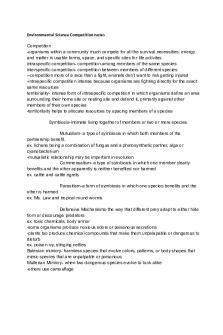Types of Competition - Econ lecture notes - 2020/2021 notes PDF

| Title | Types of Competition - Econ lecture notes - 2020/2021 notes |
|---|---|
| Course | Sports Economics |
| Institution | Ryerson University |
| Pages | 3 |
| File Size | 62.1 KB |
| File Type | |
| Total Downloads | 80 |
| Total Views | 155 |
Summary
Econ lecture notes - 2020/2021 notes...
Description
CIA 4U1 Types of Competition Perfect Competition There are many sellers in this market Sellers have no control over price The sellers are all price takers Price is determined by interaction of demand and supply Goods that are sold are similar in nature No restriction to enter this market Marginal revenue curve is flat Price = Marginal Revenue D=P=MR=AR Ex. Agricultural products or milk Monopolistic Competition There are a lot of sellers in this market, not as many as perfect competition Sellers have a little control over price Products are similar, but can be difference in packaging and style There are few restrictions for entry Competition occurs through advertising Price > marginal revenue Ex. Restaurants, convenience stores Oligopoly Competition There are a few sellers in the market (3-10) Have a fair amount of control over price Products are difference in model or style, example is cars There are many restrictions in this area by the government Competition occurs through advertising Demand curve is kinked Ex. Car manufacturing, telephone companies (dog eat dog) Monopoly Only one seller in the market This seller has complete control over price The product that is sold is very unique Heavy government regulations and restriction of entry into this market Marginal revenue is downward sloping Price is > marginal revenue Ex. Ontario Hydro
April 11th
CIA 4U1
April 11th
Entry Barriers There are six main entry barriers in oligopolies and monopolies Increasing returns to scale Market experience Restricted ownership of resources Legal obstacles (such as patents) Market abuses (such as predatory pricing) Advertising (which is most common in oligopolies) Market Power Is a business’s ability to affect the price it charges Varies with market structure, such that monopolists have the most and perfect competitors have the least Attributes of Market Structures Figure 5.1 Pg. 112 Perfect Competitor’s Demand A perfect competitor has a demand curve different from the market demand curve The business’s demand curve is horizontal at the prevailing market price Perfect competitors demand Figure 5.2 Pg. 113 Average and Marginal Revenue Total revenue is used to find two other revenue concepts Average revenue (total revenue divided by output) Marginal revenue (change in total revenue divided by change in output) Revenue Conditions for a Perfect Competitor Average revenue equals price, so that a perfect competitor’s average revenue curve is its horizontal demand curve A perfect competitor’s average revenue (price) is constant so that marginal revenue and average revenue are always equal The Profit-Maximizing Rule The profit-maximizing rule states that profit is maximized when marginal revenue equals marginal costs Output should be increased if marginal revenue exceeds marginal cost Output should be decreased if marginal cost exceeds marginal revenue The Breakeven and Shutdown Points The breakeven point is where a business breaks even while maximizing profit For a perfect competitor, this occurs where price equals minimum average cost The shutdown point is the lowest price at which a business will choose to operate in the short run It occurs where price equals minimum average variable cost
CIA 4U1
April 11th
A Perfect Competitor’s Supply Curve A perfect competitor’s supply curve is its marginal cost curve above the shutdown point The market supply curve can be found by horizontally adding the supply curves for all the businesses in the industry Pg.119 Perfect Competition in the Long Run Entry and exit by businesses in the long run drives a perfectly competitive market to the breakeven point Businesses enter markets where economic profits are made so that supply shifts right and price falls Businesses leave markets where economic losses are made so that supply shifts left and price rises The Benefits of Perfect Competition Perfectly competitive markets in long-run equilibrium meet two conditions that benefit consumers Minimum – cost pricing (price = minimum average cost) Marginal – cost pricing (price = marginal cost)
5.1 Practice Problems a) Monopolistic b) Monopoly c) Oligopoly d) Perfect e) Oligopoly 1. a) b) c) d)
2. a)
Perfect Competition Oligopoly Monopolistic Oligopoly...
Similar Free PDFs

Lecture notes perfect competition
- 10 Pages

ECON 104 Lecture Notes
- 21 Pages

ECON 1001 Lecture Notes
- 156 Pages

Competition act - Lecture notes 1
- 70 Pages

Types OF Validity - Notes
- 1 Pages

Econ CH 3 Notes - Econ Lecture
- 16 Pages

Econ 215 - Lecture notes All
- 3 Pages

Lecture notes in Mathematical econ
- 213 Pages

Notes on Competition Act
- 29 Pages
Popular Institutions
- Tinajero National High School - Annex
- Politeknik Caltex Riau
- Yokohama City University
- SGT University
- University of Al-Qadisiyah
- Divine Word College of Vigan
- Techniek College Rotterdam
- Universidade de Santiago
- Universiti Teknologi MARA Cawangan Johor Kampus Pasir Gudang
- Poltekkes Kemenkes Yogyakarta
- Baguio City National High School
- Colegio san marcos
- preparatoria uno
- Centro de Bachillerato Tecnológico Industrial y de Servicios No. 107
- Dalian Maritime University
- Quang Trung Secondary School
- Colegio Tecnológico en Informática
- Corporación Regional de Educación Superior
- Grupo CEDVA
- Dar Al Uloom University
- Centro de Estudios Preuniversitarios de la Universidad Nacional de Ingeniería
- 上智大学
- Aakash International School, Nuna Majara
- San Felipe Neri Catholic School
- Kang Chiao International School - New Taipei City
- Misamis Occidental National High School
- Institución Educativa Escuela Normal Juan Ladrilleros
- Kolehiyo ng Pantukan
- Batanes State College
- Instituto Continental
- Sekolah Menengah Kejuruan Kesehatan Kaltara (Tarakan)
- Colegio de La Inmaculada Concepcion - Cebu






